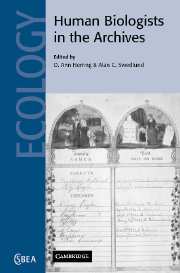 Human Biologists in the Archives
Human Biologists in the Archives Book contents
- Frontmatter
- Contents
- Contributors
- Foreword by Sydel Silverman and Michael A. Little
- Acknowledgements
- 1 Human biologists in the archives: demography, health, nutrition and genetics in historical populations
- 2 The use of archives in the study of microevolution: changing demography and epidemiology in Escazú, Costa Rica
- 3 Anthropometric data and population history
- 4 For everything there is a season: Chumash Indian births, marriages, and deaths at the Alta California missions
- 5 Children of the poor: infant mortality in the Erie County Almshouse during the mid nineteenth century
- 6 Worked to the bone: the biomechanical consequences of ‘labor therapy’ at a nineteenth century asylum
- 7 Monitored growth: anthropometrics and health history records at a private New England middle school, 1935–1960
- 8 Scarlet fever epidemics of the nineteenth century: a case of evolved pathogenic virulence?
- 9 The ecology of a health crisis: Gibraltar and the 1865 cholera epidemic
- 10 War and population composition in Åland, Finland
- 11 Infectious diseases in the historical archives: a modeling approach
- 12 Where were the women?
- 13 Malnutrition among northern peoples of Canada in the 1940s: an ecological and economic disaster
- 14 Archival research in physical anthropology
- Index
- References
13 - Malnutrition among northern peoples of Canada in the 1940s: an ecological and economic disaster
Published online by Cambridge University Press: 12 August 2009
- Frontmatter
- Contents
- Contributors
- Foreword by Sydel Silverman and Michael A. Little
- Acknowledgements
- 1 Human biologists in the archives: demography, health, nutrition and genetics in historical populations
- 2 The use of archives in the study of microevolution: changing demography and epidemiology in Escazú, Costa Rica
- 3 Anthropometric data and population history
- 4 For everything there is a season: Chumash Indian births, marriages, and deaths at the Alta California missions
- 5 Children of the poor: infant mortality in the Erie County Almshouse during the mid nineteenth century
- 6 Worked to the bone: the biomechanical consequences of ‘labor therapy’ at a nineteenth century asylum
- 7 Monitored growth: anthropometrics and health history records at a private New England middle school, 1935–1960
- 8 Scarlet fever epidemics of the nineteenth century: a case of evolved pathogenic virulence?
- 9 The ecology of a health crisis: Gibraltar and the 1865 cholera epidemic
- 10 War and population composition in Åland, Finland
- 11 Infectious diseases in the historical archives: a modeling approach
- 12 Where were the women?
- 13 Malnutrition among northern peoples of Canada in the 1940s: an ecological and economic disaster
- 14 Archival research in physical anthropology
- Index
- References
Summary
Introduction
The Hudson's Bay region of the Canadian north captured the imagination of seventeenth-century Europeans seeking the elusive northwest passage to the Far East. The romance of the north and its promise of future riches led adventurers and agents of foreign governments to explore its land and sea. They encountered a fabulous array of fur-bearing animals – beaver, ermine, mink, fox, fisher, marten, lynx, hare and muskrat – setting the stage for the development of the European fur trade and for significant shifts in human–land relationships in the north thereafter.
A system of fur trade posts was established by the Hudson's Bay Company and the Northwest Company (which merged into a single business in 1821) that served to attract Aboriginal people to the areas around the posts and to encourage more intensive trapping of fur-bearing animals, in exchange for European goods (Fig. 13.1). Prior to sustained European contact, the Cree followed a seasonal subsistence cycle based on shifting plant and animal availability (Fig. 13.2). During the fur trade, they became enmeshed in a European industry that intensified and concentrated their subsistence activities on harvesting fur-bearing animals such as the beaver. This eventually led to abandonment of the seasonal cycle of mobility and to an increasing dependence on particular tracts of land, the economy of the fur trade, and imported resources.
The demographic and ecological consequences of the fur trade, though seemingly minor at the outset, acted incrementally through time to transform life in the Canadian north (Preston 1986).
- Type
- Chapter
- Information
- Human Biologists in the ArchivesDemography, Health, Nutrition and Genetics in Historical Populations, pp. 289 - 310Publisher: Cambridge University PressPrint publication year: 2002


